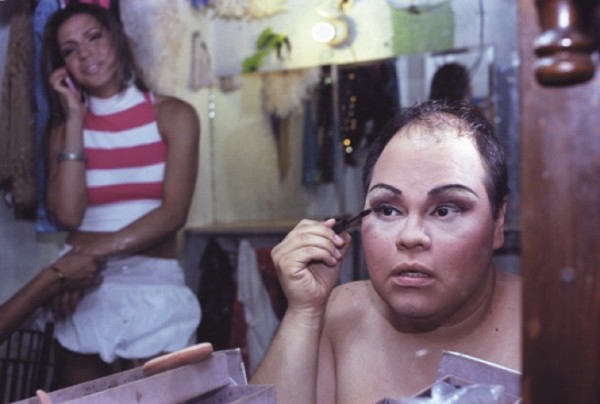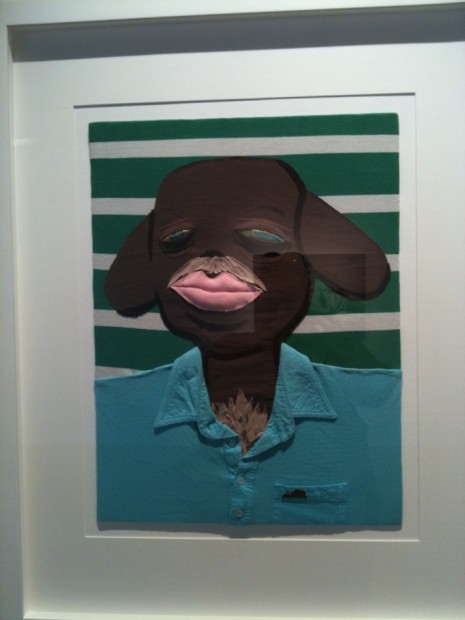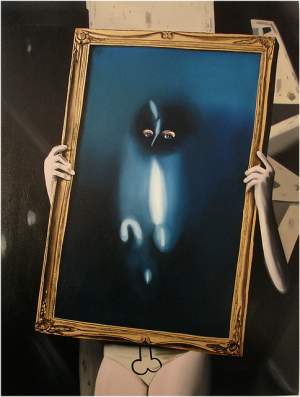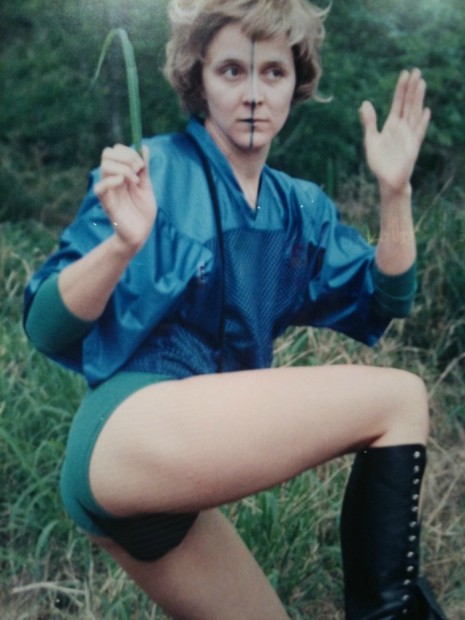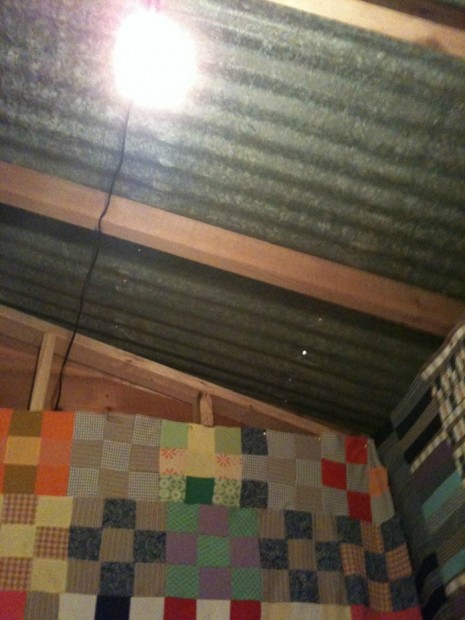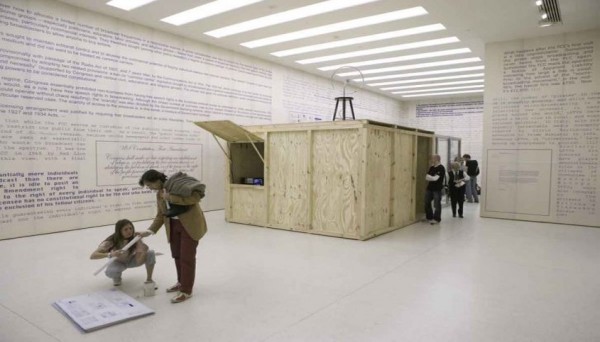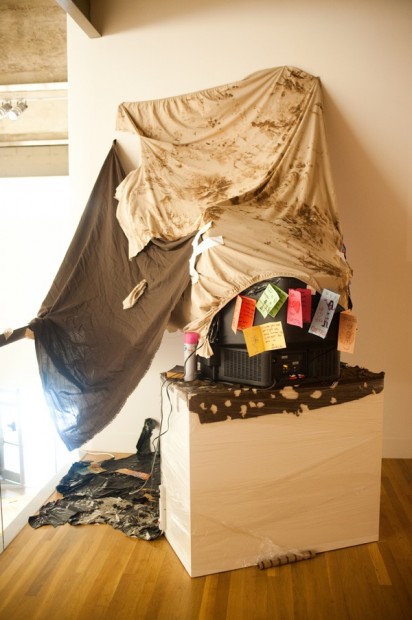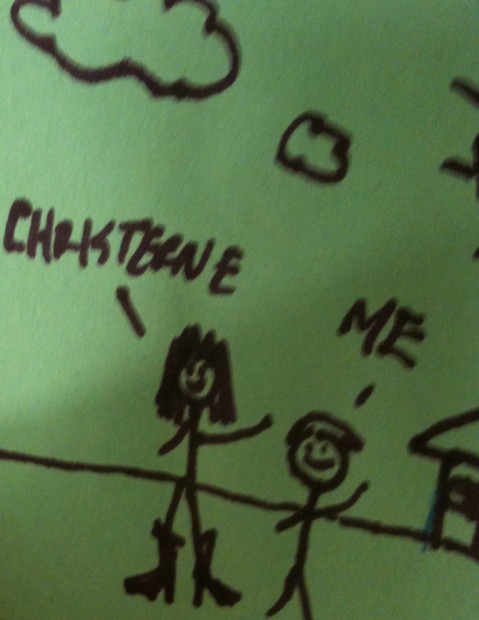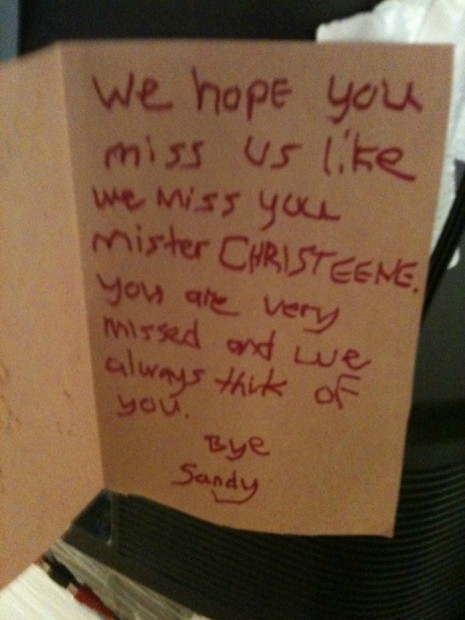My friend Rebecca watches “RuPaul’s Drag U” with her six-year-old daughter, who’s a big fan. The six-year-old, her mother believes, doesn’t understand that Jujubee, Raven and the other drag queens are not biological women. The little girl watches for more or less the same reason her mom does — for the kitschy glamor (although the kiddo doesn’t see kitsch, probably; I thought Miss Piggy exceptionally elegant when I was six), the feisty girl-power underpinnings and love thyself counseling of the smiling RuPaul, and the sassy ladies who help overworked moms and shy girls get all dressed up and put on a fancy “draguation” show for their families. Rebecca’s daughter came home from school recently and excitedly told her mom that her school music teacher “looks just like Lady Bunny!”
“I can’t wait to meet this teacher,” Rebecca told me.
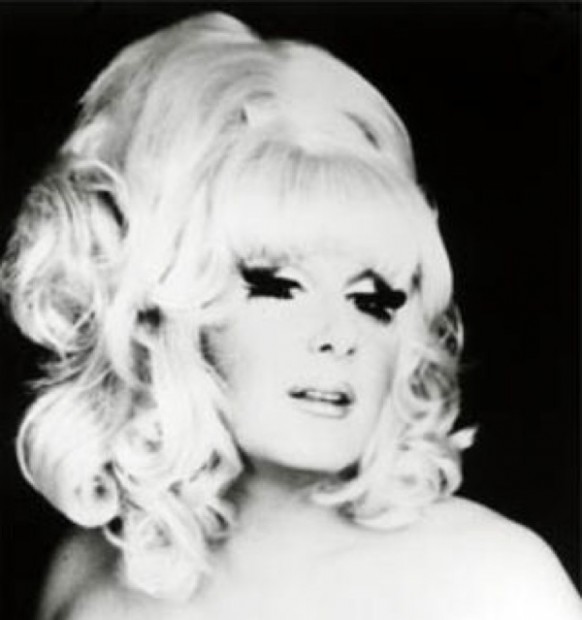
Lady Bunny. A friend who objects to drag asserts that she doesn't represent gay men, and that he can "field-dress a deer in 15 minutes." Maybe she can too, but his point is well-taken.
My friend Steven told me at lunch a few weeks ago that while his partner loves Drag U, Steven finds it problematic and a little embarrassing. A multi-degreed and accomplished arts professional, Steven, like other gay men I know — hell, like various other people I’ve known, across the preference and gender spectrum — likens drag to a form of sexual-role “cooning.” Drag, they argue, remains a convention that relegates queerness to a circus performance. Drag makes queerness both freakish and acceptable to heteronormative culture, ghettoizing the LGBT as “other” in a burlesque made of shame and stereotype. Drag complicates the increasingly positive perception of LGBT people and families, even possibly hinders the progress of marriage equality, the advances in political and professional respect, and the fight against homphobic violence and bullying.
It seems to me a worldwide human truth that no marginalized group of people is without factions: in exactly which ways are we (queers, women, people of color, the poor) being treated like shit? What’s the appropriate response? What counts as success against the oppressor? Revenge? Assimilation? What constitutes subversion, insult, revelation, obligation, remuneration?
One friend tells me he feels that Lady Gaga’s “Born This Way” feels like absolute pandering, another (teenage) friend has found in its frothy pop his heart’s own anthem. Butch dykes are teased by LGBT comrades for their supposed lack of style, and effeminate boys (and bois) are maligned by butch ones who “pass.” And on and on ’til the break of dawn.
Queer State(s), an exhibition in residence at the University of Texas’ Visual Arts Center through this Saturday, November 5, succeeds in demonstrating that “the term ‘queer’ is not meant to be literal, as in any gay artist in Texas, but rather it is meant to refer to gay, and even straight, artists that in some way engage queer sexuality in their work.” As such, it’s both enlightening and recondite. Co-curators Noah Simblist and the Fort Worth-based artist-curator David Willburn have assembled an art show of tremendous diversity with no seeming axe to grind. Simblist has managed to tackle difficult, seeming-binaries in other of his curatorial projects, whereas with Queer State(s), there’s no map or legend, and an aversion to the binary. Playful and sorrowing by turns, Queer State(s) hinges on multiple narratives and personal universes, embraces indi-visual experience — not of sex, exactly, but of sloppy, leaping life beyond the gender pale. That Simblist and Willburn gathered this compendium largely from our region is testament both to their prowess and to the South-by-Southwest region’s artistic strengths.
I’m resorting to shitty iPhone photos, yet again (I’m sorry, really), because there are some specific details of what I want to show y’all.
Here is a beautiful drawing by Heyd Fontenot,
a native Louisianian best known for his experimental films of the 1990s.
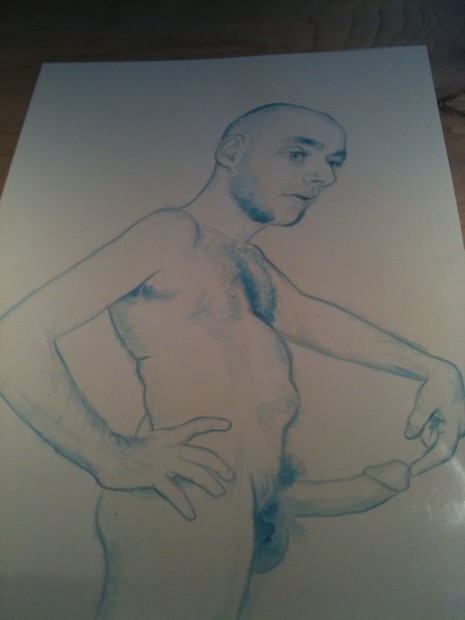
"Joe as Robert Rauschenberg, Artist, b. 1925, Port Arthur, Texas" (2011) Graphite and ink on paper. Photographed in a vitrine with 2 other drawings.
This is Fontenot as celebrator of the intimate, the lovely, and the funny. I couldn’t tell you how it relates to Rauschenberg, exactly (he was queer, though), but the subject’s guileless display of his own erection suggests the generative and exuberant aspect to any sexuality entwined with creative process. It’s a cartoon, but there’s harmony and a soft palette, a believable if ambiguous physical joy and investigation.
On his website, Fontemot muses that “If there is a radical nature to sexuality, it lies not in its ability to titillate, but rather in its inherent powers of spiritual transformation.”
This rings true to me in his depiction of this and two other lyrical male nudes, one of whom is modeled on Suzy Parker.
In the same room as the Fontenot vitrine hang works by Libby Black and Jason Villegas, two artists whose previous work had fascinated me, and whose Queer Nation(s) offerings felt totally different. For one thing, I think of them both as 3-D artists; Villegas has mastered an explosively cozy (it’s a thing) approach to sex, fashion and fabric that often springs from the walls, documenting a deeply-felt queer cosmology inhabited by erotic monsters and the hairy, often bearded, thickset subset of male beauty he loves. Black’s insidiously, gorgeously tweaked 3D renderings of luxury goods (Vuitton cases, a Prada ice axe, all of cardboard) as displayed in last Spring’s superb New Image Sculpture show at San Anotnio’s McNay Art Museum left me laughing at my own absurd envy, and laid bare the consumerist notions of value. In Queer Nation(s), Villegas and Black show wall work.
Villegas codifies his fabric sense and the wild characters of his Queer Futurism into a playful, mustachioed animal-person gay-about-town. I wasn’t as wild about his other paintings, which in the context of his larger work feel like studies, but the admixture of play, compositional strength, and expression of a self-contained sort of utopia here is sensational.
Black forgoes handmade reproductions for painting in Queer Nation(s); stark, ambiguous, almost Balthus-like depiction of disquieting narrative and recrimination. This seems like a female form peering out at the viewer from behind an abstract painting which might or might not illustrate a question mark and a penis and scrotum. The simplified graphic addition of male genitalia to the figure conjures up the much-discussed idea of the “male gaze;” girl made boyish by the act of looking, his/her penis unmistakable while contingent, semi-hidden. Is all lustful looking at least nominally male? The titling is engrossing, too, as is the suggested architectural structure behind this watcher. Black gives you ample mystery and fuel for speculation as to whom this painting implicates, and whom it/she observes.
K8 Hardy’s “Positions” series also meditates on the essential eccentricities of female desire and expectation. The image I found most beguiling and disturbing is this one:
With the blade of grass, deliberate posture, bisected face and stuffed briefs, it’s pinup as megaperson. Another of her images bears what must be a by-design crack down the middle of the print, interestingly on one of the less questionably female subjects. It’d be oversimplifying to say that Hardy’s work subverts the binary; she’s not that lazy. She’s tapping into Tiresias territory here, the classical blind seer who thrust his staff between two mating snakes and therein transformed from male to female, albeit eventually back again — whereupon he claimed that sex is better for women than for men. This puzzling bit of mythos is rich stuff, as is Hardy’s.
The marquee players in Queer State(s), to my mind, are a suite of 2-D, video and constructed installation works by Otis Ike with Ivete Lucas, Wura-Natasha Oganji’s video installation “Will I still carry water when I am a dead woman?,” and the continuing mindfuck of CHRISTEENE.
Given the perturbations surrounding drag and gender stereotype mentioned earlier in this review, the trope took on additional layers of class and culture with the Ike-observed queeriverse. On the wall, you encounter images primarily of queens of Latin America engaged in performance, behind-the-scenes primping, and the unspoken struggle of redefining identity amidst not only homophobia, but poverty. While Queer State(s) generally refrains from political out-rightness (with Wura-Natasha Oganji as a semi-exception), Ike’s works observe some pertinent overlapping socioeconomic subsets.
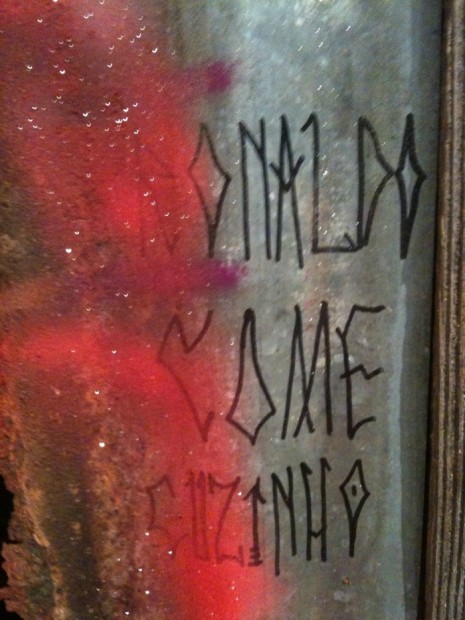
Hut entrance graffiti detail, "Ronaldo come cuzinho," translates from Portuguese as "Ronaldo eats ass."
Inside the shack, which is believably kitted out to be a semi-temporary work/live habitation in a border barrio or a Rio favela, you encounter footage of Brazilian and Mexican drag performers as they sass, dance, and beam for the camera. Surrounding the video, colored lights glow, family photos are wedged into a mirror’s frame, and collages of photos of supermodels and muscle boys exude the hypnotic power of all objects of desire; there are human beings for whom you feel sexual desire, and those you want to emulate, via aspirant desire, which is just about as intense.
This environment sketches the outline of a hundred thousand unnamed people (or more), and puts you right in the fray.
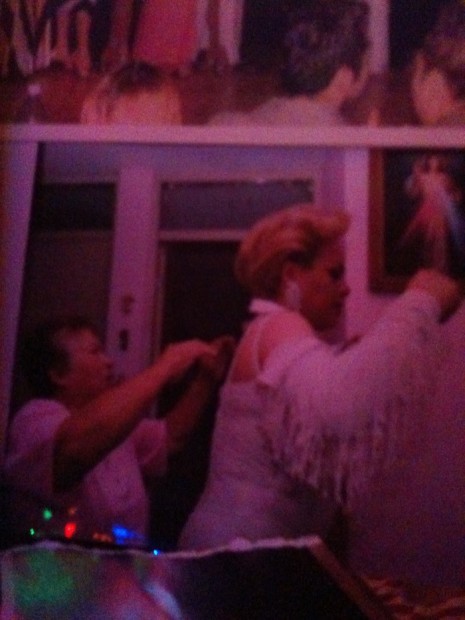
Interior hut detail; photo stuck in mirror frame of mom or abuelita helping with drag preparation, maybe.
This work delves into everything about drag that makes it problematic; these performers are backed into a corner, gender-wise, and seem to embody straight culture-directed theatrics. These queens may well have chosen alternate expressions of queer identity were they not so…ghetto. Which is kind of the point. While Queer identity has surely been ghettoized, and drag is implicated in that, drag also often emerges from actual, race- and poverty-based ghettos, worldwide; see ladyboys in Thailand, hijra in India, bakla in the Phillippines, Köçek in Turkey, Bissu in Indonesia, and Afghani Bacha posh. In places where machismo, religion, or colonialism hold rigid sway, drag (and, often and unfortunately, sex work) offer a semblance of wiggle room, an outcropping of free expression, whatever the cost. Are you relegated, or liberated? Transgressive, or traditional? This is totally anecdotal and subjective, but I don’t think I’ve ever met a white, middle-class drag queen.
The other half of the video duplex is occupied by a set-dressed presentation of the world of a precocious and very funny little boy from Ivanhoe, Virginia, part of Appalachia. This child, about nine years old, acts as docent and architectural critic as the camera follows him through his little town. The boy, dreamy and enthusiastic and almost totally unselfconscious, points out houses he loves, “Look at that! Look at it! That house is so pretty,” details “I love pansies! On the tape these look blue but they’re more purple,” and composes spontaneous local data, such as “Did you know that house has over 672 snakes?”
In the Ivanhoe half of the duplex, the exterior is Southern-poor make-do, with pages from a photo album leaking out onto the floor, pictures of old ladies, cats, couples in Olan Mills-style compositions. The interior object accoutrement consists of ratty toys including a girl doll, as well as fake plants, a half dozen or more snow globes, a Garfield pet bed, and the room is upholstered in quilts. A lone lightbulb hangs from the aluminum ceiling.
The installation stops just short of identifying this inventive, effeminate kid as queer, but identifies him, correctly or fictitiously, as poor, and thus maintains its seeming stance that in the absence of material wealth, the formation of identity is both burden and sacrosanct.
For Wura-Natasha Oganji, Queerness is fraught with peril. In her performance video “Will I still carry water when I am a dead woman?”(see it here), the artist locates herself in Lagos, Nigeria, a deeply ambivalent place given its tradition of Ife sculptures, a theme Oganji has drawn on in past works, its locus as the birthplace for many African diaspora forbears, and its rampant and much-noted homophobia. In the video, Oganji drags herself across the red ground of a ramshackle neighborhood, trailing two plastic containers meant for carrying water. This video reminded me of the work of Regina José Galindo, a Guatemalan artist famous for tracing bloody footprints (she continually dipped her bare feet in a basin of animal blood) from the Congress of Guatemala to the National Palace. Oganji struggles forward on her belly while Nigerian onlookers, including numerous children, look on, perplexed, amused, and troubled. Obviously, they’re reacting not only to the woman enacting this Beckett-like choreography of despair, but also to the video camera capturing the scene. This makes for an example of observer’s paradox, for good or ill; the act of observing by an audience of even one changes the scene; an audience composed of live people, and a camera, and a video audience is pretty well mediated, for all its raw performance.
“Will I still carry water when I am a dead woman?” is a courageous piece of both performance and filmmaking, but for all its inherent activism, the desired effect, both on the live audience and the video one, seems to me diffuse.
I’ve written about CHRISTEENE twice before; she/he is a desperate, exquisitely gifted lyricist of hip-hop and R&B who, judging by the videos, works as a sex worker on the streets of Austin. In this iteration of her mythos, CHRISTEENE houses her salacious, meta-transgressive video for “Fix My Dick,” (watch it here), a song which I originally found armored and unkind but now find myself singing in the car. The screen is in a kind of lean-to, Tiravanija-esque in a similar, less constructed way as Ike’s queer narratives hut.
CHRISTEENE’s abode is way humbler than that wooden cabin though.
Here’s the exterior:
CHRISTEENE’s improvised housing seems less a humble abode than a homeless person’s squat. She’s certainly placed herself on the streets in several of her videos, but here she (or he, if we’re talking about Paul Soileau, the artist behind the “drag terrorist”) dwells outdoors and lives rough, the most precarious of all the personae on offer, and the most ambiguous. A new twist (for me): in addition to there being an enclosure, the outside of what appears to be a shit-smeared tent, floored in tarpaper, is decorated with manqué handmade cards from children.
The children beseech her to “get better soon” and to come play outside with them again, while the seemingly ravenous, video- vixen CHRISTEENE onscreen inside the tent maintains a rat-a-tat flow about holes, poles, and needing a “baby who gonna shut the fuck up when Mama gets up to get down.” This CHRISTEENE is a nightmare monster (but great with kids) whose album, wonderfully entitled Soldier of Pleasure, would kill Pat Robertson flat dead… or maybe turn him on.
CHRISTEENE, like Otis Ike, juxtaposes queerness with notions or depictions of childhood; in CHRISTEENE’s case, she posits herself as the admired friend of a host of schoolkids who wish her the best, and she needs it — the inside of her tent is littered with lotto scratch-offs and a dangling guardian angel holy card, pointing to a homeless person hoping against hope that her/his luck will change, that somebody will fix his dick, or empathize while she rains tears from her pussy (the title and refrain of another song).
That’s a note of absurdist pathos, right there. Children’s get-well cards for a fierce, salacious, homeless sex worker, whom we don’t know whether to scorn or identify with, whose videos shows up in gallery shows, but also on internet comedy site funnyordie.com. Is CHRISTEENE/Soileau meaning to solicit empathy, or just making fun, or both? This may encapsulate the thesis of Queer State(s).
…Can you have it both ways?
____________
For eight years in New York City, Sarah Fisch defended Texas as the home of muchos smartypantses, artists, thinkers and other people who aren’t, for example, Tom deLay. New Yorkers remained skeptical. After she graduated from The New School, Fisch migrated back to San Antonio in ’08. She has worked as the arts editor at San Antonio’s altweekly The San Antonio Current, and the arts and culture staff writer at Plaza de Armas. Furthermore, Sarah Fisch (whose last name is pronounced “fish”) is the 2010 San Antonio Artist Foundation Grant winner for Literary Arts for a forthcoming book of SATX-based short fiction and was a national Endowment for the Arts / USC Annenberg / Getty Arts Journalism Program Fellow. She’s a children’s book writer, a stand-up comic and also a sound artist, which are conveniently broad categories.
AUTHOR’S NOTE: Article amended to include several more photos, thanks to the gracious courtesy of the VAC.


